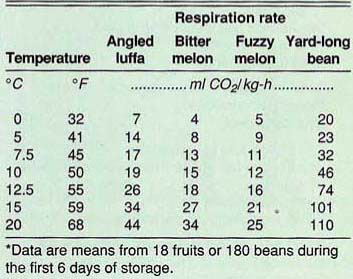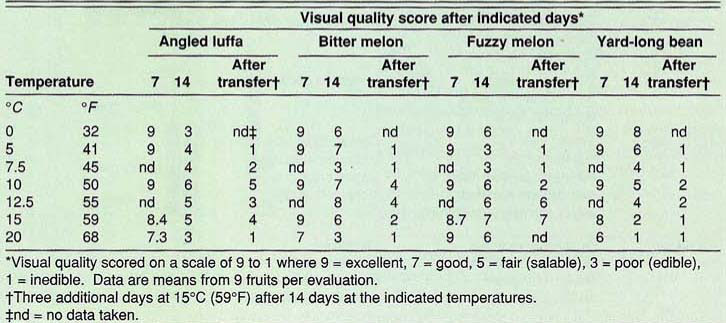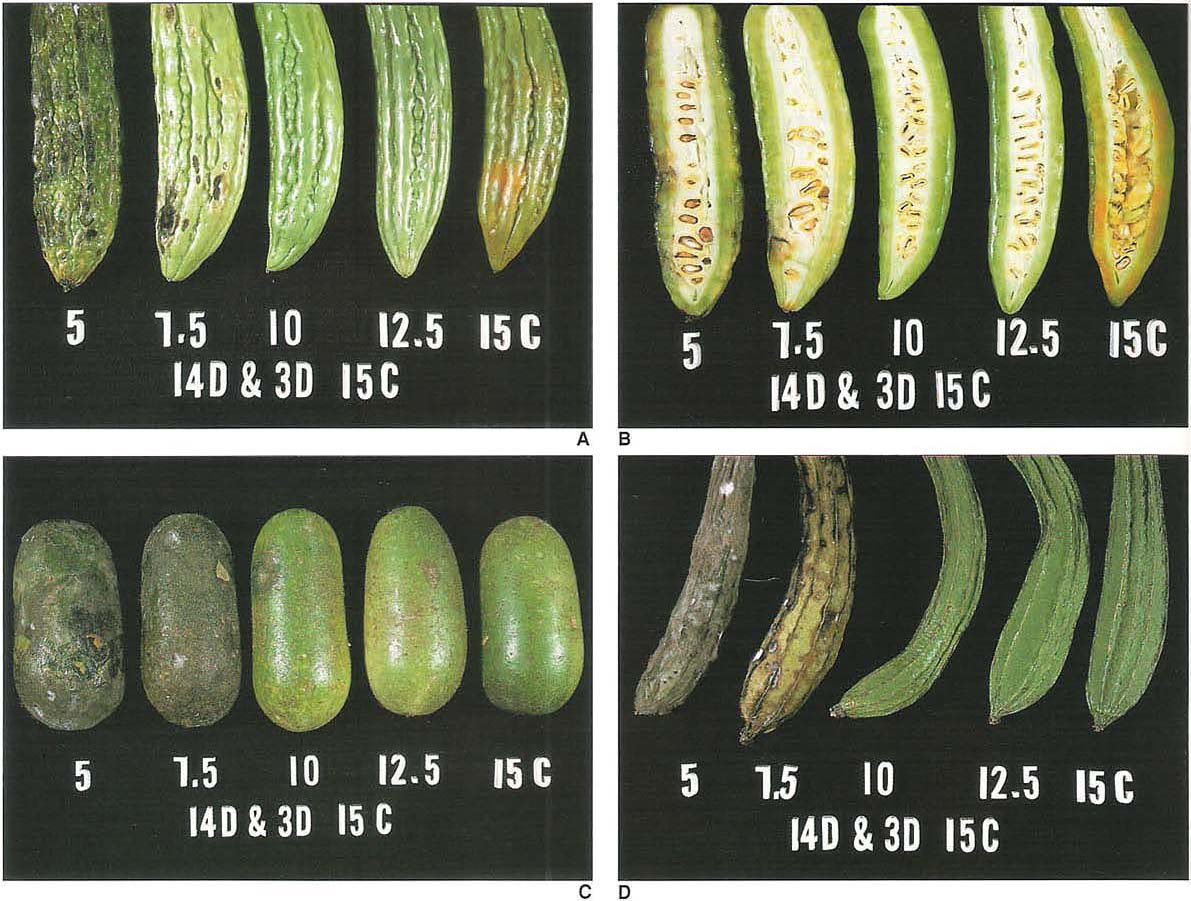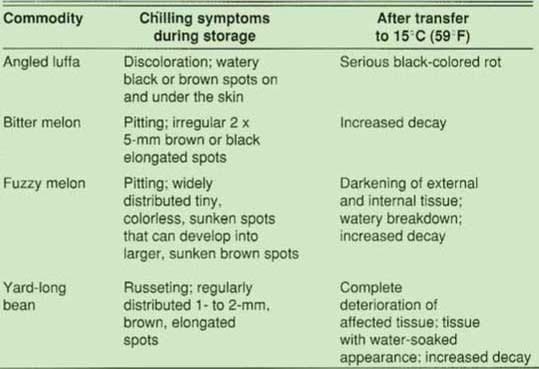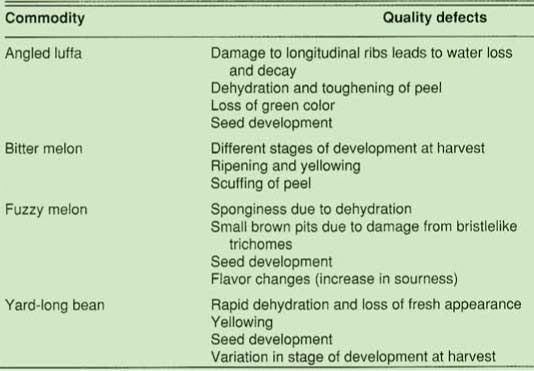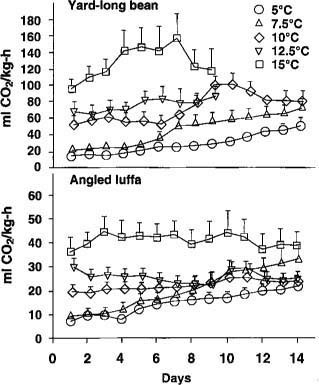All Issues
Angled luffa, bitter melon, fuzzy melon, yard-long bean… Postharvest handling of Asian specialty vegetables under study
Publication Information
California Agriculture 47(2):27-29.
Published March 01, 1993
PDF | Citation | Permissions
Abstract
The Asian specialty vegetables bitter melon, fuzzy melon, luffa and yard-long bean require good temperature management during postharvest handling to reduce deterioration and to avoid chilling injury. These vegetables can be successfully marketed for 1 to 2 weeks if kept at 10° to 12.5°C (50° to 55°F).
Full text
Expanding production of specialty vegetables in the United States during the last decade is a result of increased ethnic diversity in our population, renewed emphasis on eating healthy foods, and the successful promotion of greater variety in our diets. Many California-grown specialty vegetables marketed locally and regionally originated in subtropical or tropical areas and are sensitive to chilling, a characteristic that challenges distributors to maintain quality. Four specialty vegetables of Asian origin are considered here.
Angled luffa or Chinese okra (Luffa acutangula), a green-colored immature fruit with longitudinal ridges or ribs, is consumed much like summer squash. Mature fruits of a related species are used for their fibers, and are often called sponge gourds or luffas. The bitter melon, balsam pear or bitter gourd (Momorrdica charantia) is a white- to green-colored immature fruit with a warty appearance; as the name suggests, it is valued for its unique bitter flavor. Fuzzy melon or Chinese squash (Benincasa hispida) is an immature green-colored cylindrical fruit with many bristlelike trichomes, and is harvested and cooked lightly like summer squash. Fruits of some varieties may be left to mature to become the long-storing, edible “wax gourds.” The yard-long bean or asparagus bean (Vigna sesquipedalis) is an immature legume pod, consumed much as green beans are, but having a richer flavor.
Our study sought to describe the postharvest characteristics of these four vegetables, to provide handling recommendations, and to emphasize postharvest changes that occur in all chilling-sensitive horticultural products.
Experiment sites and methods
The experimental materials were harvested at typical commercial maturity from small-scale vegetable farms near Davis and Stockton, California. They were transported at ambient temperature to the Mann Laboratory at UC Davis. On the same day the vegetables were selected for uniformity of size and freedom from defects, placed in glass containers kept at indicated temperatures and ventilated with humidified air at rates sufficient to maintain carbon dioxide levels at <0.5%. Respiration and ethylene production rates were determined from 1-ml gaseous samples analyzed on an infrared analyzer and a gas chromatograph equipped with a flame ionization detector, respectively (table 1). Each storage treatment consisted of three replications of three to five fruits, except for yard-long bean, which had 10 fruits per replicate.
The vegetables were evaluated for quality periodically during storage and after transfer from colder storage temperatures to 15°C (59°F) to simulate marketing conditions (table 2). Visual quality, seed development and other growth-related changes, color, chilling symptoms (pitting, surface discolorations), and decay were rated on a scale of 1 to 9, where 1 = minimum expression and 9 = maximum expression. For overall visual quality, a score of 5 indicated minimum commercial acceptability.
TABLE 1. Respiration rates of angled luffa, bitter melon, fuzzy melon and yard-long bean at indicated temperatures'
TABLE 2. Changes in visual quality scores of angled luffa, bitter melon, fuzzy melon and yard-long bean stored at indicated temperatures
Visual quality of bitter melon (A and B), fuzzy melon (C) and angled luffa (D) after storage at different temperatures for 14 days. Fruits were evaluated 3 days after transfer to 15°C (59°F).
TABLE 4. Postharvest quality defects, other than chilling injury, observed on angled luffa, bitter melon, fuzzy melon and yard-long bean
Fig. 1. Respiration rates (means and standard deviations) of yard-long bean (top) and angled luffa (below) stored at 5°C (41°F), 7.5°C (45°F), 10°C (50°F), 12.5°C (55°F), and 15°C (59°F).
Respiration/ethylene production
Respiration rates are highly correlated with the degree of perishability of a harvested product. Changes in the respiratory pattern after harvest are also associated with changes in composition and other qualities. Respiration rates of angled luffa, bitter melon and fuzzy melon were moderate (25 to 40 ml CO2/ kg-hat 20°C = 68°F), and were comparable to those of slicing cucumbers but lower than those of summer squash. Respiration rates of yard-long beans were about four to five times higher than those of the cucurbit fruit vegetables, but were similar to rates of a similar product, snap beans.
Figure 1 shows how the respiration rate of yard-long beans and angled luffa changed during storage at five temperatures. Changes in respiration rates at 12.5°C (55°F) and 15°C (59°F) were associated with internal development. The continuous gradual increases in respiration rates at 5°C (41°F) and 7.5°C (45°F) indicated the onset of chilling injury.
These immature fruit vegetables produced little ethylene (<0.1 ül/kg-h at 20°C = 68°F) under normal conditions, but showed increases in “stress” ethylene when stored below 10°C (50°F). At higher temperatures (15°C = 59°F and 20°C = 68°F), yard-long beans, bitter melon and angled luffa showed internal growth changes often associated with temporary increases in ethylene production. For bitter melon, seed development was associated with other ripening-related changes, including external yellowing, internal red color development, and longitudinal splitting of the fruit. Exposure of these vegetables to ethylene at 20°C (68°F) greatly accelerated ripening and decay.
Changes after storage
Yard-long beans, it was found, can be stored successfully about 1 week, whereas angled luffa, bitter melon and fuzzy melon can be stored for about 2 weeks at 10° to 12.5°C (50° to 55°F). Quality evaluations after transfer from storage temperatures to 15°C (59°F) showed the chilling-sensitive nature of these commodities. Data for fuzzy melon (fig. 2) and the appearance of bitter melon, luffa and fuzzy melon clearly illustrate the effect of storage temperature on final quality. The most common symptoms of chilling injury and other postharvest defects (table 3) included brown or black surface discoloration, surface pitting and sunken areas and high levels of decay that began during storage and developed rapidly after transfer to warmer conditions.
Fig. 2. Visual quality (A), decay (B), black stain (C) and pitting (D) scores (means and standard deviations) of fuzzy melon stored at 7.5°C (45°F), 10°C (50°F), and 12.5°C (55°F) for 12 days. Fruits were evaluated 3 days after transfer to 15°C (59°F).
Storage of bitter melon, yard-long bean and angled luffa at temperatures below 10°C (59°F) and fuzzy melon below 12.5°C (55°F) resulted in severe chilling injury within 14 days. Nonchilling-related quality defects that occurred during storage are summarized in table 4.
Yard-long beans are particularly problematic to handle because of their high respiration rate, high chilling sensitivity, and high rates of water loss and seed development at nonchilling temperatures. Yard-long beans are often iced commercially and marketed as quickly as possible. These conditions may cause chilling injury but greatly reduce deterioration due to water loss. They will retain good quality for up to 2 weeks if stored continuously at low temperatures, but they must be consumed immediately to avoid severe chilling symptoms. Storing yard-long beans at 10°C (59°F) provides a shelf life of <1 week.
Effect of maturity at harvest
Seed and fruit development after harvest affected the overall quality of these fruit-type vegetables. Postharvest developmental changes resulted in fruit splitting and ripening in bitter melon, pod swelling in yard-long beans, thinning of the edible flesh and development of a sour flavor in the fuzzy melon, and blossom-end enlargement, stem-end shrinkage and bitter flavor development in angled luffa. Bitter melon fruits harvested at the immature or green but fully developed (mature-green) stages were similar in quality when stored at 7.5°C (45°F) and 10°C (50°F). Fully developed fruits stored at 12.5°C (55°F) and 15°C (59°F), however, showed significantly more green color loss, decay and fruit splitting than did fruits harvested immature.
Conclusions
The vegetables bitter melon, angled luffa, fuzzy melon and yard-long beans are chilling sensitive and should not be stored below 10° to 12.5°C (50° to 55°F). Visual chilling symptoms were accentuated after transfer from storage temperatures to 15°C (59°F); they included pitted lesions, russeting, black and brown surface discolorations, and a high incidence of decay. Fruit development (seed development, color changes) continued during storage at temperatures >12.5°C (59°F). Respiration rates are high for yard-long bean, and moderate for fuzzy melon, bitter melon and angled luffa. These four fruit vegetables produce very little ethylene, but exposure to ethylene during post-harvest handling accelerates color changes and reduces quality.



